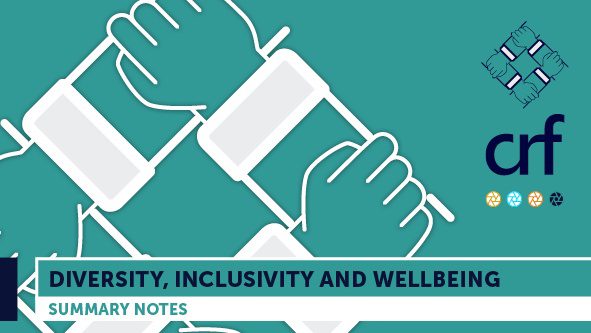D&I and Wellbeing
DI&W Summary Notes: Evidence-Based Employee Health and Wellbeing
On 13th June CRF hosted an online discussion for senior members of the Diversity, Inclusivity & Wellbeing (DI&W) community: ‘Evidence-Based Employee Health and Wellbeing.’ Chaired by CRF Research Director Gillian Pillans, the session included an overview of the latest evidence-based thinking in the field of employee health and wellbeing, a discussion of how wellbeing strategies have evolved since the pandemic and practitioner approaches to improving employee wellbeing. These notes summarise the discussion.
An Evidence-Based Approach to Employee Health and Wellbeing: An Overview
CRF Associate Research Director Prof. Rob Briner outlined the latest research in the employee health and wellbeing field and signposted how HR practitioners can take a more evidence-based approach to health and wellbeing:
- Employers have a legal duty of care as well as an ethical responsibility regarding employee wellbeing. Strong employee wellbeing is also assumed to be good for business, though there is not currently a strong evidence base that factors such as increased engagement and employee satisfaction lead to increased performance (these are more likely to be outputs of performance, rather than the cause).
- There is a long history concerning how society thinks about work and its impact on people. It’s important to focus on both the positive (e.g. employee engagement) and negative aspects (e.g. stress reduction) of wellbeing, whereas historically society has tended to focus on one or the other.
- Psychological wellbeing is a broad term which Rob Briner split into the below three categories. Whilst organisational wellbeing policies may address all these areas, it is important for HR practitioners to create a definition which works for their organisation and context:
- –Subjective – general life satisfaction, longer and shorter-term feelings.
- Psychological wellbeing – personal growth, autonomy, acceptance etc.
- Clinical conditions – e.g. clinical depression.
- Responsibility for wellbeing at work can be attributed to several different areas, including: HR, Occupational Health, the Health and Safety team, the individual, and society (e.g. through access to support or housing).
- The Job Demand Resources model outlines that job demands themselves are not necessarily harmful and can even have a positive impact on wellbeing. However, employees must have the resources (such as autonomy, practical support and material resources) to address their job demands.
Adopting an Evidence-Based Approach to Wellbeing
- Since the pandemic, employers often vocally support employee wellbeing but take little or no action that is actually effective. Interventions such as mental health first aiders or providing wellbeing related apps are popular, yet research suggests they are not effective at improving overall wellbeing.
- Instead, employers need to assess the actual causes of poor wellbeing in the workplace and then intervene appropriately. This includes identifying the major contributors to employee wellbeing, where they are located, and what is possible for employers to actually do.
- Work wellbeing is strongly influenced by non-work factors, such as a person’s personality or external content. This does not mean that organisations cannot or should not take action, but it does mean that they should identify the areas where they can reasonably make a difference.
- Prevention is better than cure: organisations should leverage work design to maximise the ‘healthy’ aspects of work and provide employees with the required support to reduce the chance that they will experience negative workplace wellbeing.
Overall, an evidence-based approach to wellbeing should:
- Begin with the business issue. Organisations should decide for themselves what they mean by wellbeing, why it’s important for their business (e.g. ethics, duty of care, business case etc) and what they want to achieve.
- Use multiple types of evidence from multiple sources to: a) understand what the wellbeing issues are within the organisation and b) identify the interventions most likely to address these.
- Design evaluations to check whether the interventions are working.
An Evidence-Based Approach to Employee Wellbeing: Practitioner Experience
Practitioners shared their own experiences and lessons learned relating to employee health and wellbeing, outlined below.
- Mental Health First Aiders. Several practitioners outlined that their organisations provide mental health first aiders and emphasised that they had found it helpful in signposting staff in crisis to support and reducing stigma. However, they also emphasised that this only works when a psychologically safe culture is in place and cautioned against using these types of interventions as a ‘sticking plaster’ for a culture where employees do not have the resources, tools or support to deliver their jobs.
- Changing Approaches Since the Pandemic. An in-session poll found that over 30% of participants had made a ‘lot of’ change in their wellbeing policy since the pandemic, and 27% had made a ‘fair amount’ of change. One participant outlined how, since the pandemic, their approach to wellbeing had changed from providing ‘pilates and a fruit basket’ to creating flexible working patterns and a culture where people felt comfortable and safe to bring themselves to work and to speak up when things aren’t going well.
- Use of data. One member shared how their organisation is using data to inform their approach to employee wellbeing. Beginning by building psychological safety to ensure staff felt comfortable to share their concerns, they deployed an internally developed app where employees could review how they felt at the end of the working day (e.g. record concerns, their energy levels etc.). They then anonymously segmented the data and are now in the process of determining interventions based on the data.
- Leveraging approaches to physical harm. One member who works at an organisation in the construction industry shared how they took their approach to on-site safety and applied this to improve office-based psychological wellbeing. This included providing a simple checklist with actions such as including a wellbeing expert once a quarter in directorate meetings or making sure people’s inclusion profile is up to date. Rob Briner also outlined the Health and Safety Executive’s Stress Management Standards which model an approach to psychosocial hazards on how physical hazards can be mitigated.
- Adopting a Risk-led approach. As well as supporting positive wellbeing, it is also important for organisations to adopt an approach which mitigates legal and reputational risks. A risk-led approach can also help organisations decide where to focus their efforts, potentially leveraging data on critical risks from vendors they are already working with.
Further Resources
CRF. 2014. Employee Health and Wellbeing – Whose Responsibility Is It?
CRF. 2020. Let’s Get Beyond Physical: Crafting a Multidimensional Approach to Employee Wellbeing
The next DI&W community event will take place on September 25th, with further details to be shared in due course. To register your interest, or if you have any further questions, please contact communities@crforum.co.uk.
MEMBER LOGIN TO ACCESS ALL CRF CONTENT




